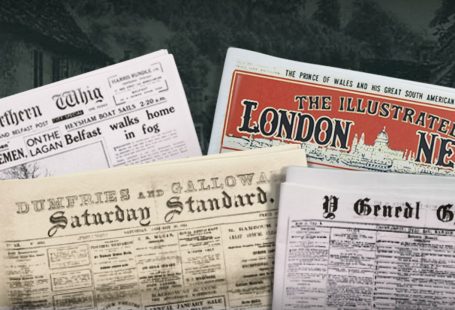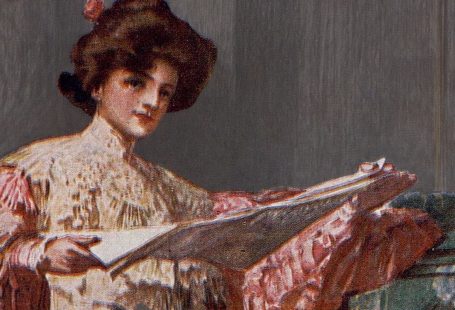In a time before mascara and lipstick, what did women of the past use for makeup? Continuing our look at the history of makeup, in this special blog we take a look at a selection of historic cosmetic tips and tricks, all sourced from the pages of the British Newspaper Archive.
Finding a mirror in the kitchen | The Sketch | 5 June 1907
Register now and explore The Archive
Rouge & Rouge Alternatives
Rouge was, historically, certainly a more risque element of a woman’s makeup, but some advice from the Gentlewoman on ‘The Gentle Art of Beauty‘ (authored by ‘Venus’ no less) in 1890 could help women from the late Victorian era colour her cheeks to create a more natural look.
‘Written mainly for gentlewomen by gentlewomen,’ the Gentlewomen was founded in 1890 as an illustrared weekly newspaper de luxe. In December of that year Venus’s article on ‘The Gentle Art of Beauty‘ appeared, and it recommended ‘the juice of an ordinary beetroot’ as a rouge alternative.
Shrine of Venus | Illustrated London News | 26 October 1889
Before the beetroot is applied, Venus encourages a lengthy preparation of the face, which should be ‘gently sponged with tepid water (if possible without soap).’ After that, ‘eau de Lubin, eau de Bully, or best of all, Mason’s Essential Oil of Eau de Cologne’ should be applied, which would give ‘a very desirable feeling of freshness.’
We are still not ready, however, to apply the beetroot. The face should be dampened with ‘a fairly strong solution of alum water,’ and then powder should be applied. Venus recommends ‘Mr Mason’s Bloom of Stephanotis,’ which should be put on with ‘a piece of chamois leather, instead of the ordinary puff, as it can be rubbed into the skin, and so remain on much longer.’
Finally, Venus then advises her reader to ‘dip a rather thick camel’s-hair brush into the beetroot juice.’ The beetroot needs to have been cut up previously, and left to stand and drain for a little while. The cheek is painted with the beetroot juice as ‘desired,’ and then more powder is added (with the aid of the chamois leather), in order ‘to tone down too voyant a colouring.’
Penny Illustrated Paper | 26 August 1899
This is 1890, after all, and a gentlewoman would not want to seem too painted. Venus underlines this point by commenting how ‘The indiscriminate use of powder is not a thing to be admired; indeed, it is absolutely disgusting, especially to men.’
Some sixteen years later, the Gentlewoman advertises a ‘Pure Liquid Rouge,’ which is made ‘from Rose Leaves’ and ‘Prepared in all shades to suit any complexion.’ Like the beetroot, it was promised to be ‘Natural and undetectable.’
In 1913 another rouge alternative is promoted by the Gentlewoman. In an article entitled ‘The Cult of Beauty,’ a collection of ‘Beauty Hints from Near and Far,’ ‘powdered colliandum’ is described as being ‘quite harmless,’ as well as defying detection, for ‘rouge is always obvious.’
Eyebrows – Brilliantine & Alcohol
Venus in ‘The Gentle Art of Beauty‘ writes how the eyebrows are ‘frequently overlooked’ but ‘are in reality an important feature.’ She offers brilliantine (the men’s hair softener) as a way of darkening eyebrows:
After washing the face, pass one finger covered with a good brilliantine over the eyebrow, and then with the thumb and first finger coax it into order, afterward touching it up gently with a fine tooth comb. There is no need for any dye, the brilliantine itself keeping the hair several shades darker.
Hampstead & Highgate Express | 12 December 1896
Whilst across the pond in Canada, the Toronto Daily Mail was touting alcohol as a way of darkening eyebrows and eyelashes. It does warn not to get it in the eyes, ‘as it will sting and inflame them.’
However, in the same 1891 article, brilliantine is again offered as ‘the nicest and safest way of improving the eyebrows.’ Meanwhile, ‘the actor’s pencil ruins the delicate hairs on the brows an lashes, while brilliantine is just as good for effect, as it darkens the hair.’
Fast forward to 1907, and the Daily Mirror is giving some beauty advice to its readers, by way of a conversation between two women named Belinda and Mrs Templar. The Daily Mirror was originally intended, like the Gentlewoman, to be a newspaper for women by women, and was at the forefront of bringing makeup tips and tricks to the mainstream, as was seen by the publication of its Beauty Book in 1910.
Belinda is keen to know whether ‘there is any lotion or cream that will make the eyebrows grow.’ Mrs Templar, in response, sounds a note of caution, stating how ‘a great deal of perseverance is needed with any eyebrow lotion.’ Her lotion ‘should be used regularly each night for at least twelve months and should be applied with a clean new tooth-brush.’ It could be made as follows:
Mix two and a half ounces of eau de Cologne with one and a half ounces of glycerine and two drachms of fluid extract of jaborandi.
Eyelashes – Vaseline & Castor Oil
Naturally after such care has been taken to the eyebrows, we move to the eyelashes. According to the Gentlewoman in 1913 ‘In days gone by women used to clip their lashes, to make them grow longer and stronger.’ This rather extreme practice was apparently unsuccessful, and the Gentlewoman offers a chemist-produced pomade-like substance called ‘mennaline’ to promote the growth of eyelashes, as well as darkening them.
Britannia and Eve | 1 April 1934
Mrs Templar had her own method of darkening eyelashes, as detailed below:
She can darken them with a mixture composed of three and a half drachms of indian-ink with two drachms of gum Arabic and eight ounces of rose water. This can be applied to the lashes by means of a camel-hair brush, and a small piece of cardboard can be placed under the lower lashes in order that the stain may not darken the cheek.
Meanwhile The Berwick Advertiser in 1917 offers a ‘good way to darken the eyelashes, and to make them grow gradually and naturally.’ Namely – smearing them and the eyelids ‘every night with white Vaseline’ (something my own grandmother swore by), whilst the Beeston Gazette and Echo suggests the regular application of castor oil.
Pearson’s Weekly | 15 November 1906
Skincare – Barley & Hot Milk
Mrs Templar was also a treasure trove of advice for various skincare preparations. One of her correspondents was suffering from a sore face after having been ‘motoring in cold winds.’ Mrs Templar advises this particular lady to ‘bathe her face in hot milk,’ which will ‘clean and soften it.’
Furthermore, a healing paste could be made from ‘three ounces of ground barley, one ounce of honey and the beaten-up white of an egg.’ This should be kept on all night, ‘and may be removed in the morning by washing with distilled water.’
Meanwhile, Connie Lester had got in touch with Belinda and Mrs Templar to ask for a ‘good cleansing cream for the face,’ that could be made without the use of soap.
Mrs Templar’s recipe is as follows:
Melt one ounce each of spermaceti and white wax in a jar placed in boiling water, and add four ounces of almond oil. Stir it all well together, and when it is well incorporated take the jar out of the boiling water and beat in, drop by drop, four ounces of orange flower water. This cream is not only an emollient and a cleanser for the skin, but also assists materially in whitening it. The best way to apply it is to smear a little on the face, rub it gently in with the fingers, and then, taking a piece of soft lint or rag, wipe the face thoroughly.
Lips & Hair
Venus, in ‘The Gentle Art of Beauty,’ does not neglect the lips, which otherwise do seem to be neglected by other beauty writers (although the Daily Mirror‘s Beauty Book does contain a recipe to create ‘cherry lips’). Venus writes that the ‘lips…can be improved on occasions by wetting the finger with scent and rubbing it on them, this causing them to become a lovely red tint.’
We also found some novel home recipes for the hair. The Berwick Advertiser suggests that a small quantity of oil should be applied before curlers are put in, in order to keep the hair ‘in curl all day.’
The same article from 1917 suggests that fair hair can be brightened with ‘half an ounce of powdered sulphur and one ounce of powdered orris root.’ This should be sprinkled into the hair at night and brushed out in the morning.
The Beeston Gazette and Echo in 1936 is also giving some interesting advice regarding the brightening of blonde hair, remarking how ‘lemon juice will give fair hair a brilliant sheen:’
Strain the juice of lemon and mix it with two quarts of water, adding a heaped teaspoonful of salts of tartar. Use this as a final rinse, and dry the hair with warm towels in a warm room, though not near a fire.
Britannia and Eve | 1 September 1941
We hope you enjoyed our exploration of these historic beauty and cosmetic tips and tricks! You can learn more about the Daily Mirror’s historic Beauty Book here, whilst look out for more on how lipstick changed everything in the 1920s, and how the makeup revolution transformed women’s self-expression in the early twentieth century.
















